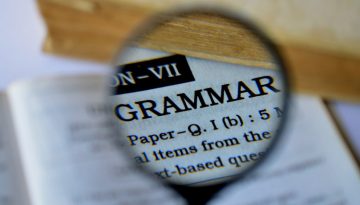The Romance of Legal English
The Romance of Legal English
Hello and Happy New Year!
Christmas holidays are supposed to be a festive time when families and friends come together to enjoy food, drinks and each other’s company. I’m leaving Baby Jesus out of it not to be disrespectful but because I’m having a bit of a hard time squeezing him into the point I’d like to make. ?
At this time of the year, we hear an abundance of pleasant words such as jingle, merry, gifts and lamb which immediately set the mood right. However, this year the Christmas glossary somehow also included words like bug, headache and snot – so much for the mood, then. Everyone, including myself, came down with something and it was rather difficult to feel festive coughing my head off surrounded by snotty handkerchiefs.
Anyway, I was determined to enjoy the season and start the New Year on a positive note so I devote this post to what I find beautiful about Legal English.
Teaching Legal English may sound like (and often is) a drag. It’s hard to turn a lesson on real estate law into a vivid and fun group discussion no matter how passionate the students feel about the subject. There are times, though, when the subject offers an exciting peek into the past and sparks a rare debate on the history of the English language and its development.
I’m talking about the archaic and peculiar nature of legal vocabulary and grammatical structures, of course. Believe it or not, I’ve spoken about William Shakespeare and Beowulf more often in my Legal English classes than the General English ones!
The history of Legal English is long and eventful. To keep it simple, let’s just say its historical milestones are closely linked to the conquests of Britain and the linguistic influences brought about by the conquerors. Therefore, reading a legal text today often feels like time travel where bits and bobs of languages otherwise long gone or transformed into something entirely different are still present, alive and well.

The Romans and Latin
The Roman invasion (from AD 43) brought about prominence of Latin as the language of elites, politics and, of course, law. Modern Legal English still uses many Latin expressions and words of Latin origin with meanings usually expressed by other words in General English.
e.g. inter alia, bona fide, ad hoc, ex parte etc.
In the US, a subpoena (from Medieval Latin sub pena – under penalty) compelling a witness to appear in court often ends with the dramatic archaic threat:
“Fail not, at your own peril.”
If you’re not familiar with the meaning of peril (from Latin periculum – attempt, trial, experiment; risk, danger) or the old-fashioned structure of “fail not”, you may not be particularly shaken but translate it into plain English and the chills are there immediately:
You can be arrested if you do not show up at the court.
You would go, wouldn’t you? ?
THE ANGLO-SAXONS AND OLD ENGLISH
The Germanic invaders (the Angles, Saxons and Jutes, circa 410) discussed their legal matters in Germanic vernacular, which later developed into Old English.
The first Germanic language law code, The Law of Æthelberht (dating to the early 7th century) is thought to be the first document written in Old English and the earliest law code of any kind written in any Germanic language.
I’m not going to quote Old English here because 1) I can’t and 2) my computer doesn’t have an Old English keyboard. Anyway, the Anglo-Saxon influence is present all over Modern English.
For example, if you ever find yourself in need to say the following:
“All right, you liar! Cut it out or I will kick your arse!”,
you might feel bolder knowing that all the words in this sentence are either directly inherited from Old English or formed from Anglo-Saxon roots. (This is where I mention Beowulf in class.)
Enter William the Conqueror!
The year of 1066 marked the Norman invasion and the next 300 years of Anglo-Norman French which later developed into Law French and became the official language of legal proceedings. Law French suffered a lethal blow in 1362 when the Parliament finally had it and enacted the Statute of Pleading (or the Pleading in English Act 1362) which complains that because the common people of England did not speak Norman French, they were left in the dark regarding the legal matters they were involved in. The Act stipulated that:
“All Pleas which shall be pleaded in [any] Courts whatsoever, before any of his Justices whatsoever, or in his other Places, or before any of His other Ministers whatsoever, or in the Courts and Places of any other Lords whatsoever within the Realm, shall be pleaded, shewed, defended, answered, debated, and judged in the English language, and that they be entered and inrolled in Latin”.
OK, clear enough. Stop with the French, speak in English, write in Latin. But this is where it gets interesting!
Apart from the old form of show (‘shewed’) and the archaic spelling of enrolled (‘inrolled’), you could easily slip this sentence into a modern contract, complete with the shall’s, the whatsoever’s and the passives. I’m quite sure my students wouldn’t even blink if they came across it. 1362!
If you’re interested what Anglo-Saxon (Old English) and Middle English may have sounded like, click here. 🙂
ENGLISH ONLY, PLEASE! SERIOUSLY.
Latin, however, continued to be used in written legal documents until 18th century when it was replaced by English in the Proceedings in Courts of Justice Act 1730. Because only highly educated people were fluent in Latin, it was never actually spoken in court proceedings. However, you might still catch it in courtrooms today. The words objection, litigation and judge are all of Latin origin.
obiection (Lat.) – a throwing or putting before
litigare (Lat.) – to dispute, carry on a suit
iudex (Lat.) – one who declares the law
WHAT ABOUT WILLIAM SHAKESPEARE?
We have skipped the turn of 16th-17th century, missing one of the greatest influencers (to use a trendy word) of the English language. William Shakespeare (1564 – 1616) was, without question, a master of eloquence. He invented many words and phrases that we commonly use today. That’s a well-known fact and a lot has been written on the subject. What’s perhaps less known is that he was a master of legal terminology, as well. It’s actually one of the main features of his style. Examples can be found in many of his dialogues.
As Professor Crystal points out:
“He seems to know them inside out. [ ]Words like ‘accusation’, ‘sentence’ and ‘execution’ belong to criminal law. Words like ‘statute’, ‘franchise’ and ‘counsellor’ belong to civil law. Words like ‘surety’, ‘indenture’ and ‘audit’ belong to commercial law. Just think of all the terms to do with the hearing of a case: ’cause’, ‘party’, ‘petition’, ‘suit’, ‘hearing’, ‘warrant’, ‘redress’, ‘oath’, ‘resolution’, ‘action’, ‘witness’. They all turn up in Shakespeare, and some of them very frequently. ‘Suit’ and ‘witness’ turn up over 100 times each, for example. [ ] All kinds of characters, from highest to lowest, sprinkle their speech with legalisms.
from Speak, in the Name of Law (D. Crystal, Entertainment Law Journal, Volume 1, No. 2, p. 110-111, Frank Cass, London)
Even the skull in Hamlet belongs to Yorick, the court jester! (OK, not a court of justice jester, more like a royal court jester but I just couldn’t help the joke! :-))
Isn’t that fascinating?
Summary
Knowing all this, you can’t help but read legal texts with a new perspective. Suddenly, the dry wording of contracts gains a new, more romantic quality, evoking images of medieval battles, kings and queens and starched collars. I think it would be a great shame not to include this in a Legal English course. I often slip snippets of the English language history into my classes, usually accompanied by my typical: “Isn’t that fascinating?” The students usually laugh or throw in a slightly sarcastic “amazing!” but they never seem bored or overwhelmed. Why should they? They’re bright. They can take it. ?










